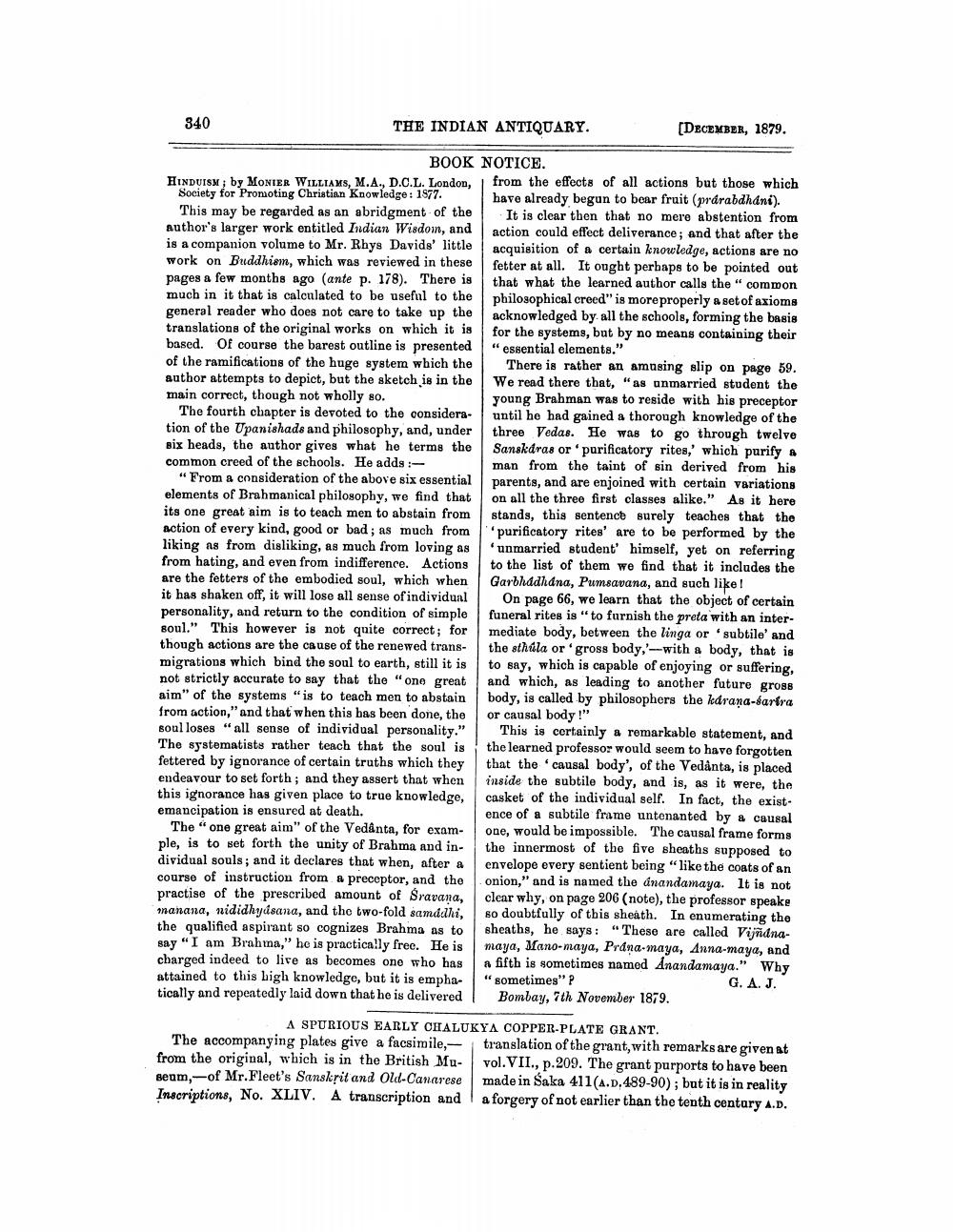________________
340
THE INDIAN ANTIQUARY.
BOOK NOTICE.
HINDUISM; by MONIER WILLIAMS, M.A., D.C.L. London, Society for Promoting Christian Knowledge: 1877.
This may be regarded as an abridgment of the author's larger work entitled Indian Wisdom, and is a companion volume to Mr. Rhys Davids' little work on Buddhism, which was reviewed in these pages a few months ago (ante p. 178). There is much in it that is calculated to be useful to the general reader who does not care to take up the translations of the original works on which it is based. Of course the barest outline is presented of the ramifications of the huge system which the author attempts to depict, but the sketch is in the main correct, though not wholly so.
The fourth chapter is devoted to the consideration of the Upanishads and philosophy, and, under six heads, the author gives what he terms the common creed of the schools. He adds:
"From a consideration of the above six essential elements of Brahmanical philosophy, we find that its one great aim is to teach men to abstain from action of every kind, good or bad; as much from liking as from disliking, as much from loving as from hating, and even from indifference. Actions are the fetters of the embodied soul, which when it has shaken off, it will lose all sense of individual personality, and return to the condition of simple soul." This however is not quite correct; for though actions are the cause of the renewed transmigrations which bind the soul to earth, still it is not strictly accurate to say that the "one great aim" of the systems "is to teach men to abstain from action," and that when this has been done, the soul loses "all sense of individual personality." The systematists rather teach that the soul is fettered by ignorance of certain truths which they endeavour to set forth; and they assert that when this ignorance has given place to true knowledge, emancipation is ensured at death.
The "one great aim" of the Vedanta, for example, is to set forth the unity of Brahma and individual souls; and it declares that when, after a course of instruction from a preceptor, and the practise of the prescribed amount of Sravana, manana, nididhyasana, and the two-fold samddhi, the qualified aspirant so cognizes Brahma as to say "I am Brahma," he is practically free. He is charged indeed to live as becomes one who has attained to this high knowledge, but it is emphatically and repeatedly laid down that he is delivered
[DECEMBER, 1879.
from the effects of all actions but those which have already begun to bear fruit (prárabdháni).
It is clear then that no mere abstention from action could effect deliverance; and that after the acquisition of a certain knowledge, actions are no fetter at all. It ought perhaps to be pointed out that what the learned author calls the "common philosophical creed" is more properly a set of axioms acknowledged by all the schools, forming the basis for the systems, but by no means containing their "essential elements."
There is rather an amusing slip on page 59. We read there that, "as unmarried student the young Brahman was to reside with his preceptor until he had gained a thorough knowledge of the three Vedas. He was to go through twelve Sanskaras or purificatory rites,' which purify a man from the taint of sin derived from his parents, and are enjoined with certain variations on all the three first classes alike." As it here stands, this sentence surely teaches that the purificatory rites' are to be performed by the 'unmarried student' himself, yet on referring to the list of them we find that it includes the Garbhadhána, Pumsavana, and such like!
On page 66, we learn that the object of certain funeral rites is "to furnish the preta with an intermediate body, between the linga or 'subtile' and the sthula or gross body,'-with a body, that is to say, which is capable of enjoying or suffering, and which, as leading to another future gross body, is called by philosophers the karana-sartra or causal body!"
This is certainly a remarkable statement, and the learned professor would seem to have forgotten that the causal body', of the Vedanta, is placed inside the subtile body, and is, as it were, the casket of the individual self. In fact, the existence of a subtile frame untenanted by a causal one, would be impossible. The causal frame forms the innermost of the five sheaths supposed to envelope every sentient being "like the coats of an onion," and is named the anandamaya. It is not clear why, on page 206 (note), the professor speake so doubtfully of this sheath. In enumerating the sheaths, he says: "These are called Vijnanamaya, Mano-maya, Prána-maya, Anna-maya, and a fifth is sometimes named Anandamaya." Why "sometimes"? Bombay, 7th November 1879.
G. A. J.
A SPURIOUS EARLY CHALUKYA The accompanying plates give a facsimile,from the original, which is in the British Museum, of Mr. Fleet's Sanskrit and Old-Canarese Inscriptions, No. XLIV. A transcription and
COPPER-PLATE GRANT. translation of the grant, with remarks are given at vol. VII., p.209. The grant purports to have been made in Saka 411(A.D.489-90); but it is in reality a forgery of not earlier than the tenth century A.D.




